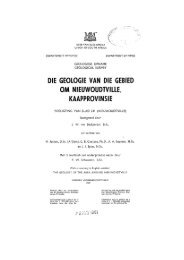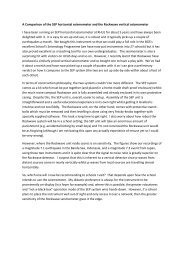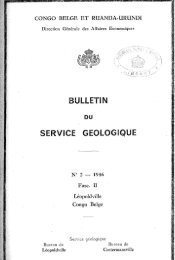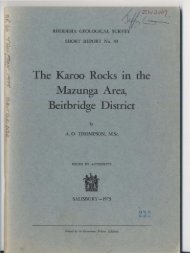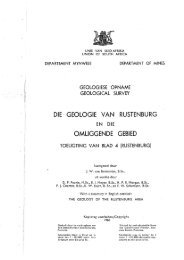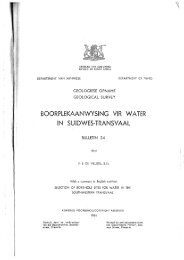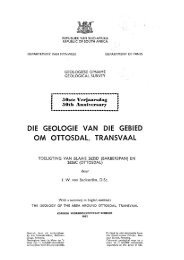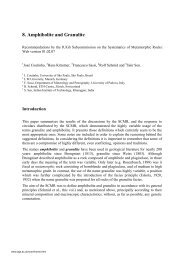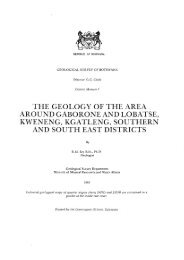Bibliography - British Geological Survey
Bibliography - British Geological Survey
Bibliography - British Geological Survey
Create successful ePaper yourself
Turn your PDF publications into a flip-book with our unique Google optimized e-Paper software.
Costello, P. 1981a. Teilhard and the Piltdown hoax. Antiquity, 55 (Mar), no. 213, 58–59. (Presents<br />
evidence refuting Gould’s claim of a conspiracy between Teilhard de Chardin and Dawson. See also<br />
editorial by Glyn Daniel in this issue, ibid., 2–4.)<br />
Costello, P. 1981b. Piltdown puzzle. New Scientist, 91 (14 Sep), 823. (The correspondent, who is writing a<br />
book about the Piltdown affair, points out many factual defects in Harrison Matthew’s entertaining and<br />
colourful version of events at Piltdown, recently serialised in the New Scientist. The case against Teilhard de<br />
Chardin is shown to be seriously flawed.)<br />
Costello, P. 1983 (see Doyle)<br />
Costello, P. 1985. The Piltdown hoax reconsidered. Antiquity, 59, no. 227 (Nov), 167–173, plates XXX–<br />
XXXII. (Accuses Dawson’s friend, the Uckfield analytical chemist, Samuel Allinson Woodhead, of being<br />
the Piltdown hoaxer. A prefatory note by Glyn Daniel, the journal editor, describes the paper as a resume of<br />
Costello’s forthcoming book ‘setting out his complete investigation into the mystery, and coming to what we<br />
believe is the proper and final solution.’ This book appears never to have been published. Costello’s defence<br />
of Dawson brings forth some useful new information concerning the circumstances under which Castle Lodge<br />
was purchased. Costello also obtained confirmation of the ‘coconut’ story from the daughter of Alfred Thorpe,<br />
the labourer who discovered the skull at Barkham Manor. In explanation of how the skull might have come<br />
to be there, he learned from a local resident that the adjacent field is called Church Field, and found evidence<br />
that medieval plague victims had been buried ‘on the common’ (on this point see Garner-Howe 1997b). He<br />
also reproduces (Plate XXXII) part of an O.S. six-inch map held by the Sussex Archaeological Society, on<br />
which Smith Woodward has indicated the field, just south of Sheffield Park, where he believed Piltdown II<br />
had been found. A signed annotation reads: ‘P is the field from the sweepings of which in 1915 I suppose the<br />
remains of the second Piltdown Skull were obtained by Charles Dawson.’ Costello’s case against Woodhead<br />
is based on a distorted reading of letters written by Woodhead’s two sons, one of which puts Dawson in a<br />
suspicious light, yet is interpreted by Costello in a completely opposite sense! See Spencer 1990b for transcripts<br />
of the earlier letters, together with comments.)<br />
Costello, P. 1986. The Piltdown hoax: beyond the Hewitt connection. Antiquity, 60, no. 229 (July), 145–<br />
147. (While Costello finds himself easily convinced of Prof. John Hewitt’s involvement in the Piltdown<br />
fraud, based on the recollections of Elizabeth Pryce (Daniel 1986), the editor, Glyn Daniel, admits that Dr<br />
Garry Moss, who has undertaken some historical research and knows about the suggested connection between<br />
Hewitt and the Piltdown skull, has not turned up any firm evidence to support it. Costello suggests that Hewitt<br />
sourced the orangutan jaw from one of his contacts at Imperial College or Cambridge. Cambridge physical<br />
anthropologists such as Haddon and Duckworth had well-known connections with Borneo. ‘Dr Jack Trevor,<br />
a Cambridge anthropologist of a later generation at the Duckworth Laboratory, had his interest in Piltdown<br />
sparked off by a rumour that Duckworth was involved in the hoax (Papers: Cambridge University Library).’<br />
Costello concludes: ‘One thing is certain at least, Charles Dawson was innocent.’)<br />
Costello, P. 1990a. Piltdown: the forger pinned down. Sunday Times, 7 Oct, 3, 8.<br />
Costello, P. 1990b. Piltdown plot. New Scientist, 128 (20 Oct), 59. (A criticism of Frank Spencer’s case<br />
against Arthur Keith. The writer, who boldly claims to speak ‘from a position of authority on the Piltdown<br />
fraud’, repeats his own case against Woodhead and Hewitt. An editorial cartoon by Austin is included, with<br />
the words ‘There’s a lot of inbreeding up on Piltdown.’)<br />
Cox, D. R. 1983. Piltdown debate: not so elementary. Science 83, 4 (9), 21–22. (A response to Winslow &<br />
Meyer 1983, drawing attention to misconceptions and omissions in their characterisation of Conan Doyle)<br />
Craddock, P. 2009. Scientific investigation of copies, fakes and forgeries. Oxford: Butterworth-<br />
Heinemann (Elsevier), 640 pp. (Ch. 19: Scientific fraud and Charles Dawson, pp. 471–496)<br />
Craddock, P. & Lang, J. 2004. Charles Dawson and the earliest cast iron: his 100% fake record maintained<br />
intact! HMS News, Historical Metallurgy Society, 58, 3–4.<br />
Craddock, P. & Lang, J. 2005. Charles Dawson’s cast-iron statuette: the authentication of iron antiquities<br />
and possible coal-smelting of iron in Roman Britain. Historical Metallurgy, 39 (1), 32‒44. (Scientific<br />
examination of Charles Dawson’s iron statuette and another small figure found more recently at the same<br />
Roman iron smelting site at Beauport Park, Sussex, has shown both to be of coal- or coke-smelted grey cast<br />
iron. The sulphur and manganese contents of the Dawson statuette strongly suggest that it is Victorian, and<br />
not Roman as stated by him. It had also been treated with potassium dichromate, as were the finds from



